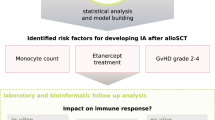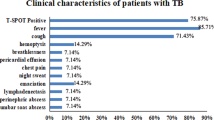Abstract
Invasive fungal infections (IFIs) are major complications after allogeneic hematopoietic SCT (HSCT). PCR-based assays able to detect fungal DNA have been reported to precede clinical diagnosis of IFI. We performed a prospective study to evaluate a PCR-based pre-emptive approach. Ninety-nine patients undergoing reduced-intensity conditioning (RIC) HSCT were followed with fungal PCR during the first 100 days post transplantation. Patients who tested positive were randomized to receive liposomal amphotericin B, or to no intervention. After day 100, PCR tests were performed only on clinical suspicion of IFI. A single positive PCR test was not associated with IFI, irrespective of treatment. After day 100, PCR tests for Aspergillus did not contribute to diagnosis of invasive aspergillosis (IA). The cumulative incidence rates of proven or probable IA during the first year after transplantation were 9%. GVHD grades II–IV (P=0.0014), CMV-seronegative recipient with CMV-seropositive donor (P⩽0.001), and conditioning with alemtuzumab (P=0.014) were significant risk factors for developing IA in a multivariate model. In this study, PCR on peripheral blood was a poor indicator of IFI early after RIC HSCT. Aspergillus PCR tests performed on clinical suspicion after day 100 were insufficiently sensitive to be diagnostically useful.
This is a preview of subscription content, access via your institution
Access options
Subscribe to this journal
Receive 12 print issues and online access
$259.00 per year
only $21.58 per issue
Buy this article
- Purchase on Springer Link
- Instant access to full article PDF
Prices may be subject to local taxes which are calculated during checkout


Similar content being viewed by others
References
Clift RA . Candidiasis in the transplant patient. Am J Med 1984; 77: 34–38.
Cordonnier C, Ribaud P, Herbrecht R, Milpied N, Valteau-Couanet D, Morgan C et al. Prognostic factors for death due to invasive aspergillosis after hematopoietic stem cell transplantation: a 1-year retrospective study of consecutive patients at French transplantation centers. Clin Infect Dis 2006; 42: 955–963.
Marr KA, Carter RA, Crippa F, Wald A, Corey L . Epidemiology and outcome of mould infections in hematopoietic stem cell transplant recipients. Clin Infect Dis 2002; 34: 909–917.
Tollemar J, Ringden O, Bostrom L, Nilsson B, Sundberg B . Variables predicting deep fungal infections in bone marrow transplant recipients. Bone Marrow Transplant 1989; 4: 635–641.
Fukuda T, Boeckh M, Carter RA, Sandmaier BM, Maris MB, Maloney DG et al. Risks and outcomes of invasive fungal infections in recipients of allogeneic hematopoietic stem cell transplants after nonmyeloablative conditioning. Blood 2003; 102: 827–833.
Hagen EA, Stern H, Porter D, Duffy K, Foley K, Luger S et al. High rate of invasive fungal infections following nonmyeloablative allogeneic transplantation. Clin Infect Dis 2003; 36: 9–15.
Junghanss C, Marr KA, Carter RA, Sandmaier BM, Maris MB, Maloney DG et al. Incidence and outcome of bacterial and fungal infections following nonmyeloablative compared with myeloablative allogeneic hematopoietic stem cell transplantation: a matched control study. Biol Blood Marrow Transplant 2002; 8: 512–520.
Kojima R, Kami M, Nannya Y, Kusumi E, Sakai M, Tanaka Y et al. Incidence of invasive aspergillosis after allogeneic hematopoietic stem cell transplantation with a reduced-intensity regimen compared with transplantation with a conventional regimen. Biol Blood Marrow Transplant 2004; 10: 645–652.
Labbe AC, Su SH, Laverdiere M, Pepin J, Patino C, Cohen S et al. High incidence of invasive aspergillosis associated with intestinal graft-versus-host disease following nonmyeloablative transplantation. Biol Blood Marrow Transplant 2007; 13: 1192–1200.
Slavin S, Nagler A, Naparstek E, Kapelushnik Y, Aker M, Cividalli G et al. Nonmyeloablative stem cell transplantation and cell therapy as an alternative to conventional bone marrow transplantation with lethal cytoreduction for the treatment of malignant and nonmalignant hematologic diseases. Blood 1998; 91: 756–763.
von Eiff M, Roos N, Schulten R, Hesse M, Zuhlsdorf M, van de Loo J . Pulmonary aspergillosis: early diagnosis improves survival. Respiration 1995; 62: 341–347.
Berenguer J, Buck M, Witebsky F, Stock F, Pizzo PA, Walsh TJ . Lysis-centrifugation blood cultures in the detection of tissue-proven invasive candidiasis. Disseminated versus single-organ infection. Diagn Microbiol Infect Dis 1993; 17: 103–109.
Ascioglu S, Rex JH, de Pauw B, Bennett JE, Bille J, Crokaert F et al. Defining opportunistic invasive fungal infections in immunocompromised patients with cancer and hematopoietic stem cell transplants: an international consensus. Clin Infect Dis 2002; 34: 7–14.
Chryssanthou E, Klingspor L, Tollemar J, Petrini B, Larsson L, Christensson B et al. PCR and other non-culture methods for diagnosis of invasive Candida infections in allogeneic bone marrow and solid organ transplant recipients. Mycoses 1999; 42: 239–247.
Halliday C, Hoile R, Sorrell T, James G, Yadav S, Shaw P et al. Role of prospective screening of blood for invasive aspergillosis by polymerase chain reaction in febrile neutropenic recipients of haematopoietic stem cell transplants and patients with acute leukaemia. Br J Haematol 2006; 132: 478–486.
Hebart H, Loffler J, Meisner C, Serey F, Schmidt D, Bohme A et al. Early detection of aspergillus infection after allogeneic stem cell transplantation by polymerase chain reaction screening. J Infect Dis 2000; 181: 1713–1719.
Jordanides NE, Allan EK, McLintock LA, Copland M, Devaney M, Stewart K et al. A prospective study of real-time panfungal PCR for the early diagnosis of invasive fungal infection in haemato-oncology patients. Bone Marrow Transplant 2005; 35: 389–395.
Lass-Florl C, Gunsilius E, Gastl G, Bonatti H, Freund MC, Gschwendtner A et al. Diagnosing invasive aspergillosis during antifungal therapy by PCR analysis of blood samples. J Clin Microbiol 2004; 42: 4154–4157.
Klingspor L, Jalal S . Molecular detection and identification of Candida and Aspergillus spp. from clinical samples using real-time PCR. Clin Microbiol Infect 2006; 12: 745–753.
Ljungman P, Lore K, Aschan J, Klaesson S, Lewensohn-Fuchs I, Lonnqvist B et al. Use of a semi-quantitative PCR for cytomegalovirus DNA as a basis for pre-emptive antiviral therapy in allogeneic bone marrow transplant patients. Bone Marrow Transplant 1996; 17: 583–587.
Tollemar J, Klingspor L, Ringden O . Liposomal amphotericin B (AmBisome) for fungal infections in immunocompromised adults and children. Clin Microbiol Infect 2001; 7 (Suppl 2): 68–79.
Ringden O, Meunier F, Tollemar J, Ricci P, Tura S, Kuse E et al. Efficacy of amphotericin B encapsulated in liposomes (AmBisome) in the treatment of invasive fungal infections in immunocompromised patients. J Antimicrob Chemother 1991; 28 (Suppl B): 73–82.
Hentschke P, Barkholt L, Uzunel M, Mattsson J, Wersall P, Pisa P et al. Low-intensity conditioning and hematopoietic stem cell transplantation in patients with renal and colon carcinoma. Bone Marrow Transplant 2003; 31: 253–261.
Ringden O, Remberger M, Persson U, Ljungman P, Aldener A, Andstrom E et al. Similar incidence of graft-versus-host disease using HLA-A, -B and -DR identical unrelated bone marrow donors as with HLA-identical siblings. Bone Marrow Transplant 1995; 15: 619–625.
Lundgren G, Wilczek H, Lonnqvist B, Lindholm A, Wahren B, Ringden O . Acyclovir prophylaxis in bone marrow transplant recipients. Scand J Infect Dis Suppl 1985; 47: 137–144.
Avetisyan G, Aschan J, Hagglund H, Ringden O, Ljungman P . Evaluation of intervention strategy based on CMV-specific immune responses after allogeneic SCT. Bone Marrow Transplant 2007; 40: 865–869.
Loeffler J, Schmidt K, Hebart H, Schumacher U, Einsele H . Automated extraction of genomic DNA from medically important yeast species and filamentous fungi by using the MagNA Pure LC system. J Clin Microbiol 2002; 40: 2240–2243.
Jensen HE, Christensen JP, Bisgaard M, Nielsen OL . Immunohistochemistry for the diagnosis of aspergillosis in Turkey poults. Avian Pathol 1997; 26: 5–18.
Gooley TA, Leisenring W, Crowley J, Storer BE . Estimation of failure probabilities in the presence of competing risks: new representations of old estimators. Stat Med 1999; 18: 695–706.
Fine J, Gray R . Proportional hazard model for the sub-distribution of competing risks. J Am Stat Assoc 1999; 94: 496–509.
Buchheidt D, Hummel M, Schleiermacher D, Spiess B, Schwerdtfeger R, Cornely OA et al. Prospective clinical evaluation of a LightCycler-mediated polymerase chain reaction assay, a nested-PCR assay and a galactomannan enzyme-linked immunosorbent assay for detection of invasive aspergillosis in neutropenic cancer patients and haematological stem cell transplant recipients. Br J Haematol 2004; 125: 196–202.
Lass-Florl C, Aigner J, Gunsilius E, Petzer A, Nachbaur D, Gastl G et al. Screening for Aspergillus spp. using polymerase chain reaction of whole blood samples from patients with haematological malignancies. Br J Haematol 2001; 113: 180–184.
Millon L, Grengouillet F, Crouzet J, Larosa F, Loewert S, Bellinger AP et al. False-positive Aspergillus real-time PCR assay due to nutritional supplement in allo-BMT recipient with GVH disease (abstract). Mycoses 2009; 52 (Suppl 1): 88.
Florent M, Katsahian S, Vekhoff A, Levy V, Rio B, Marie JP et al. Prospective evaluation of a polymerase chain reaction-ELISA targeted to Aspergillus fumigatus and Aspergillus flavus for the early diagnosis of invasive aspergillosis in patients with hematological malignancies. J Infect Dis 2006; 193: 741–747.
Ribeiro P, Costa F, Monteiro A, Caldas J, Silva M, Ferreira G et al. Polymerase chain reaction screening for fungemia and/or invasive fungal infections in patients with hematologic malignancies. Support Care Cancer 2006; 14: 469–474.
Andstrom EE, Ringden O, Remberger M, Svahn BM, Tollemar J . Safety and efficacy of liposomal amphotericin B in allogeneic bone marrow transplant recipients. Mycoses 1996; 39: 185–193.
Slavin MA, Osborne B, Adams R, Levenstein MJ, Schoch HG, Feldman AR et al. Efficacy and safety of fluconazole prophylaxis for fungal infections after marrow transplantation—a prospective, randomized, double-blind study. J Infect Dis 1995; 171: 1545–1552.
Post MJ, Lass-Floerl C, Gastl G, Nachbaur D . Invasive fungal infections in allogeneic and autologous stem cell transplant recipients: a single-center study of 166 transplanted patients. Transpl Infect Dis 2007; 9: 189–195.
Marr KA, Carter RA, Boeckh M, Martin P, Corey L . Invasive aspergillosis in allogeneic stem cell transplant recipients: changes in epidemiology and risk factors. Blood 2002; 100: 4358–4366.
Martino R, Subira M, Rovira M, Solano C, Vazquez L, Sanz GF et al. Invasive fungal infections after allogeneic peripheral blood stem cell transplantation: incidence and risk factors in 395 patients. Br J Haematol 2002; 116: 475–482.
Martin SI, Marty FM, Fiumara K, Treon SP, Gribben JG, Baden LR . Infectious complications associated with alemtuzumab use for lymphoproliferative disorders. Clin Infect Dis 2006; 43: 16–24.
Mihu CN, King E, Yossepovitch O, Taur Y, Jakubowski A, Pamer E et al. Risk factors and attributable mortality of late aspergillosis after T-cell depleted hematopoietic stem cell transplantation. Transpl Infect Dis 2008; 10: 162–167.
Nichols WG, Corey L, Gooley T, Davis C, Boeckh M . High risk of death due to bacterial and fungal infection among cytomegalovirus (CMV)-seronegative recipients of stem cell transplants from seropositive donors: evidence for indirect effects of primary CMV infection. J Infect Dis 2002; 185: 273–282.
Ullmann AJ, Lipton JH, Vesole DH, Chandrasekar P, Langston A, Tarantolo SR et al. Posaconazole or fluconazole for prophylaxis in severe graft-versus-host disease. N Engl J Med 2007; 356: 335–347.
Acknowledgements
This study was supported by a grant from Swedish Orphan. We thank Professor H Jensen, Copenhagen, Denmark, for diagnostic help with immunohistochemistry, and the staff at the Center for Allogeneic Stem Cell Transplantation.
Author information
Authors and Affiliations
Corresponding author
Ethics declarations
Competing interests
The authors declare no conflict of interest.
Rights and permissions
About this article
Cite this article
Blennow, O., Remberger, M., Klingspor, L. et al. Randomized PCR-based therapy and risk factors for invasive fungal infection following reduced-intensity conditioning and hematopoietic SCT. Bone Marrow Transplant 45, 1710–1718 (2010). https://doi.org/10.1038/bmt.2010.38
Received:
Revised:
Accepted:
Published:
Issue Date:
DOI: https://doi.org/10.1038/bmt.2010.38
Keywords
This article is cited by
-
Systematic review and mixed treatment comparison meta-analysis of randomized clinical trials of primary oral antifungal prophylaxis in allogeneic hematopoietic cell transplant recipients
BMC Infectious Diseases (2015)
-
Incidence and risk factors of post-engraftment invasive fungal disease in adult allogeneic hematopoietic stem cell transplant recipients receiving oral azoles prophylaxis
Bone Marrow Transplantation (2015)
-
Advancing the Field: Evidence for New Management Strategies in Invasive Fungal Infections
Current Fungal Infection Reports (2013)
-
Hematopoietic Stem Cell Transplantation for Acute Myeloid Leukemia: To Whom, When, and How
Current Oncology Reports (2013)
-
Standardization of Aspergillus PCR diagnosis
Bone Marrow Transplantation (2012)



